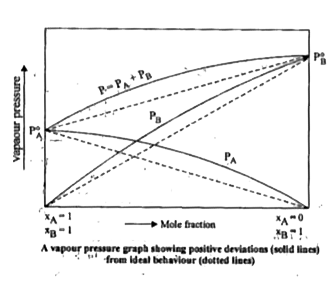Mention three characteristics of ideal solutions . What cause deviation from ideal behaviour ? Discuss the + ve deviation from ideal behaviour for ilquid pairs Solution in Punjabi
Characteristics of an ideal solution . a solution which obeys Raoult.s law exactly at all concentrations and all temperatures is called an ideal solution . For ideal heat change upon mixing (ΔHmix) and volume change upon mixing (ΔVmix) are equal t zero i.e., ΔHmix=0ΔVmix=
Cause of deviation from ideal solution behaviour :
1. Solutions of two components A (solute) and B (solvent) in which A . . . . B moleular interactions are different from A . . . . . A and B . . . . . B interactions
2. There is a change in volume when solute and solvent are mixed i.e. ΔV≠0
3. There is change in enthalpy i.e. ΔH≠0
4. The solution is not dilute i.e., the cone of solution is more than 5%

Solutions showing positive deviations from Raoult.s law. In solution showing this type of deviations, the partial pressure of each component (say A and B) of solutions is greater than that as expected according
PA>P∘xAandPB>P∘BxBA
The positive deviations have been shows in figure in which the solid lines exhibit the actual behaviour on mixing , while the dotted lines show the ideal behaviour. This type of deviations are shown by solutions in which like molecules have greater attraction for each other than the unlike molecules .
Explanation for positive deviations. Let us explain by considering a solution of ethanol and cyclohexane. In ethanol, the molecules are held together due to hydrogen bonding as shown below .
.....C2H5∣O−H.....C2H5∣O−H.....C2H5∣O−H.....C2H5∣O−H....
On adding cyclohexane, the cyclohexane molecules get in between the molecules of ethanol , thus breading the hydrogen bonds, As the resulting solution has weaker intermolecular attractions, the escaping tendency of alcohol and cyclohexane molecules from the solutions increases. Consequently, the vapour pressure of the solution is greater than the vapour pressure as expected from Raoult.s law
Topper's Solved these Questions
- BOOK - BETTER CHOICE PUBLICATIONCHAPTER - SOLUTIONSEXERCISE - Question Bank (2 .6 Colligative Properties And Determination of Molar Mass)28videos
SOLUTIONS
- BOOK - BETTER CHOICE PUBLICATIONCHAPTER - SOLUTIONSEXERCISE - Question Bank (2 .7 Abnormal Molar Mass)13videos
SOLUTIONS
- BOOK - BETTER CHOICE PUBLICATIONCHAPTER - SOLUTIONSEXERCISE - Question Bank (2 .4 Vapour Pressure of Liquid Solutions)9videos
SOLUTIONS
- BOOK - BETTER CHOICE PUBLICATIONCHAPTER - POLYMERSEXERCISE - QUESTIONS42videos
POLYMERS
- BOOK - BETTER CHOICE PUBLICATIONCHAPTER - STRUCTURE OF ATOMEXERCISE - NUMERICAL PROBLEMS6videos
STRUCTURE OF ATOM
Similar Questions
What are colligative properties ? Name four such properties.
05:55View SolutionWhy is great care is taken in intravenous injection to have comparable concentration of solutions to be injected to that of blood plasma /
01:20View Solution(a) Define vapour pressure
(b) Explain why vapour pressure of a solvent lowered by the addition of non-volatile solute ?View SolutionExplain the terms polymers and monomers ?
12:11View SolutionThe ionisation energy of hydrogen atom is given to be 13-6 eV. A photon falls a hydrogen atom which is initially in the ground state and excites it to the n = 4 state.Calculate the wavelength of the photon.
03:47View SolutionDeviation From Ideal Behaviour
02:30View SolutionFor a gas deviation from ideal behaviour is maximum at :
View SolutionKCI in water deviates from ideal behaviour-why?
03:05View SolutionDeviation From Ideal Behaviour
02:32View SolutionMention of causes for the deviation of ral gas from ideal behaviour.
01:02View SolutionWhat are the causes for deviation of real gases from ideal behaviour.
07:13View SolutionMention three characteristics of ideal solutions. What cause deviation from ideal behaviour ? Discuss the positive deviations from ideal behaviour.
07:53View SolutionExplain the causes for deviation for real gases from ideal behaviour.
03:07View SolutionExplain the causes for deviation for real gases from ideal behaviour.
02:37View SolutionA real gas deviates most from ideal behaviour at
02:51View SolutionExplain the causes for deviation for real gases from ideal behaviour.
02:32View Solution

